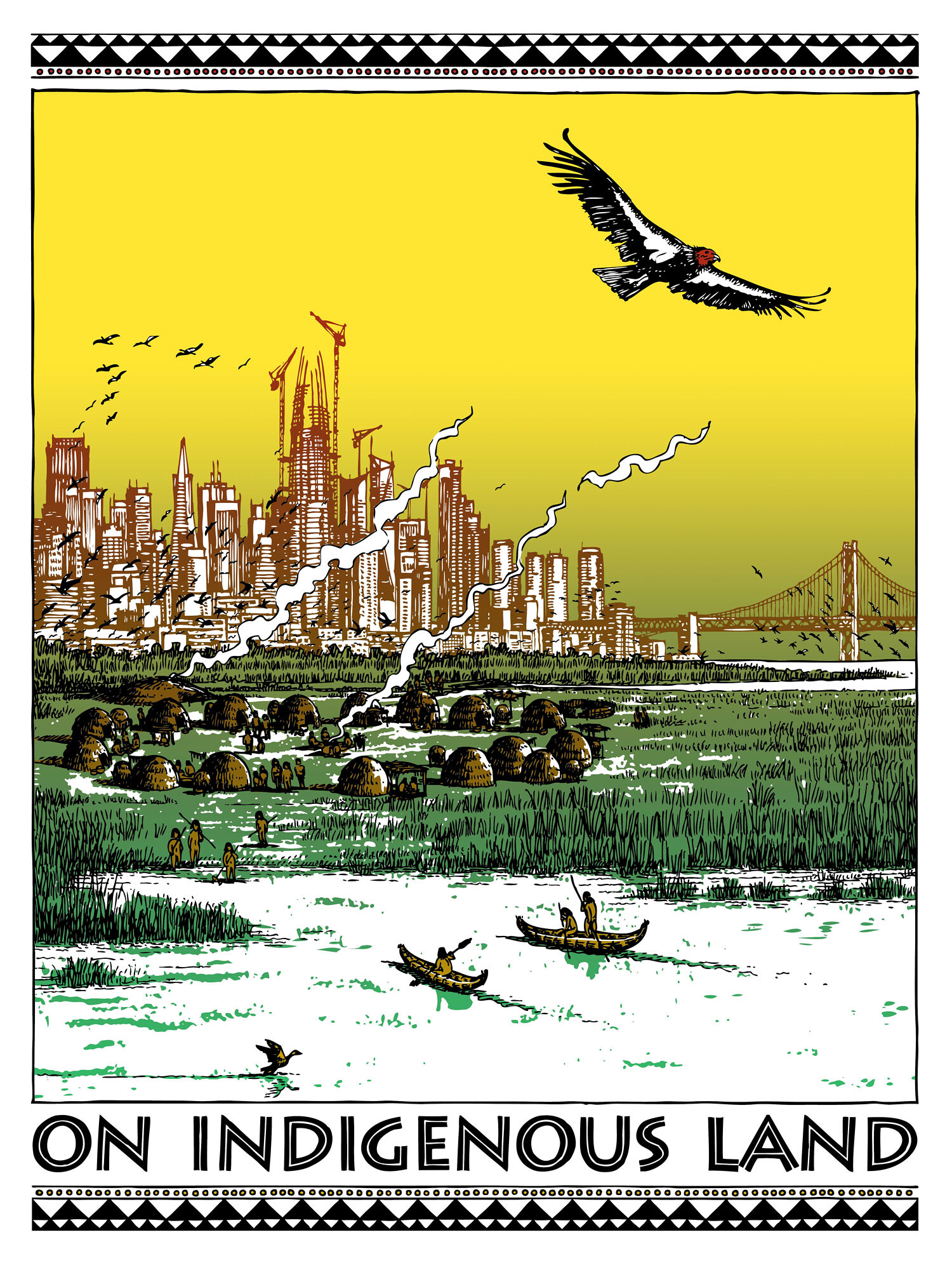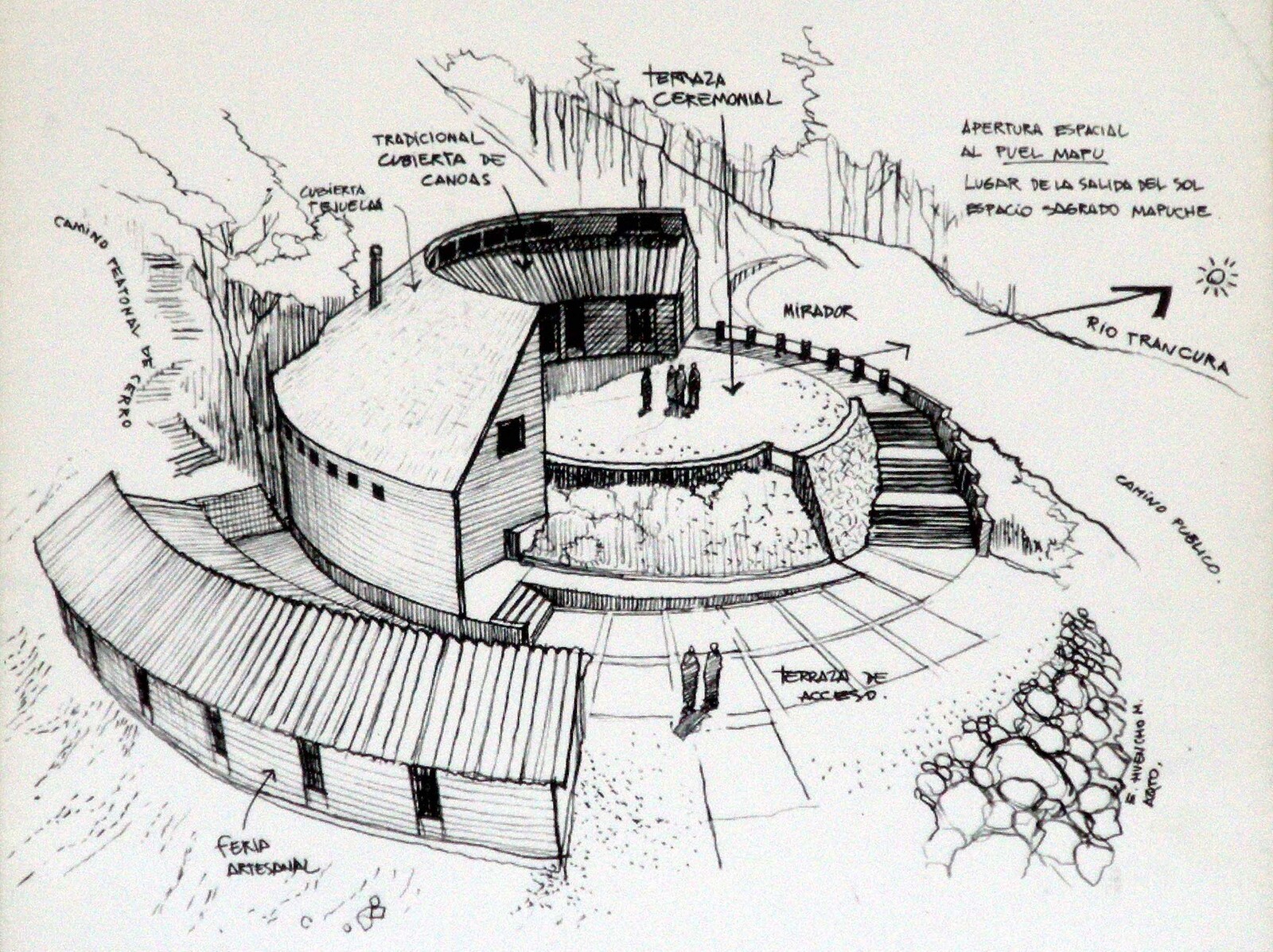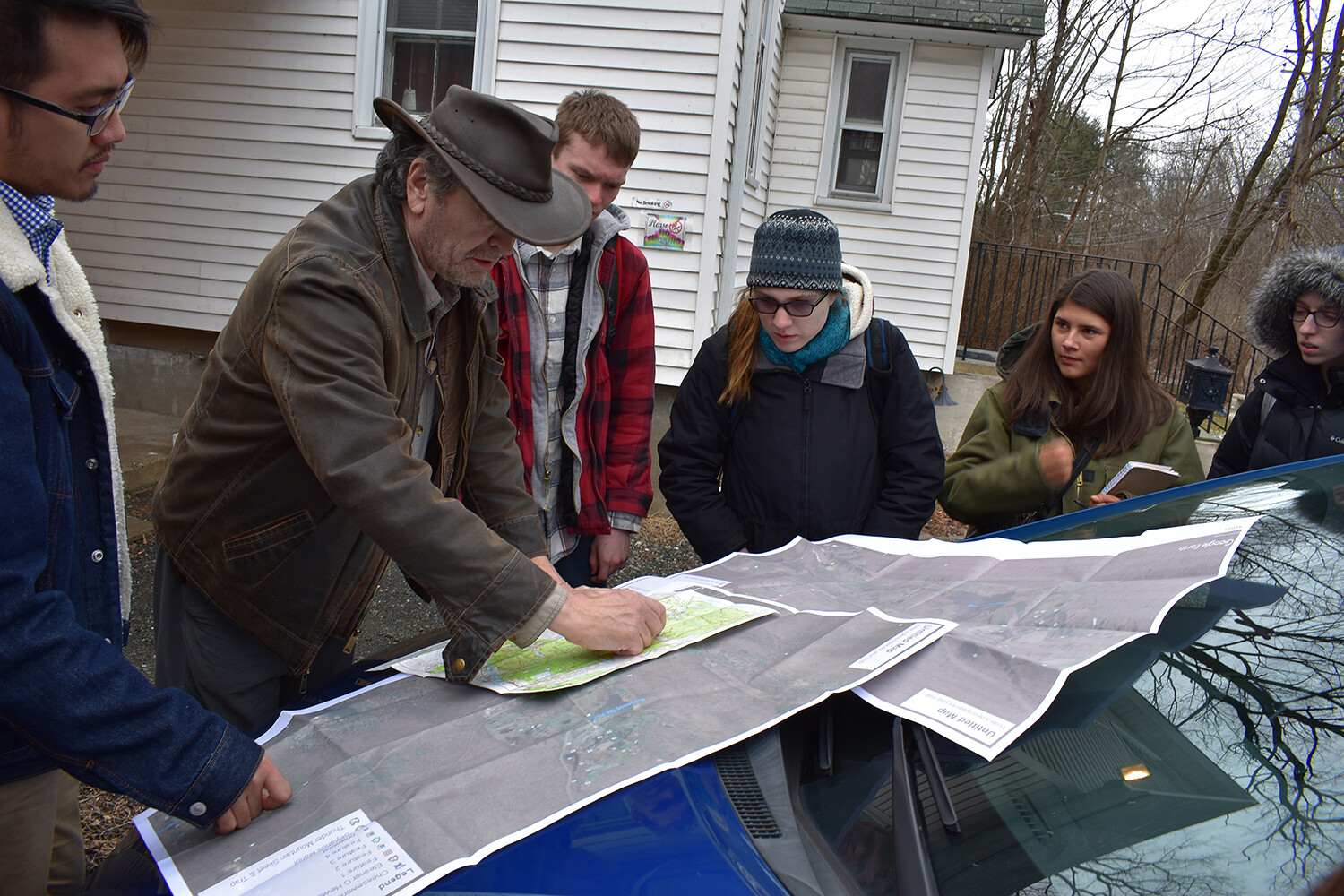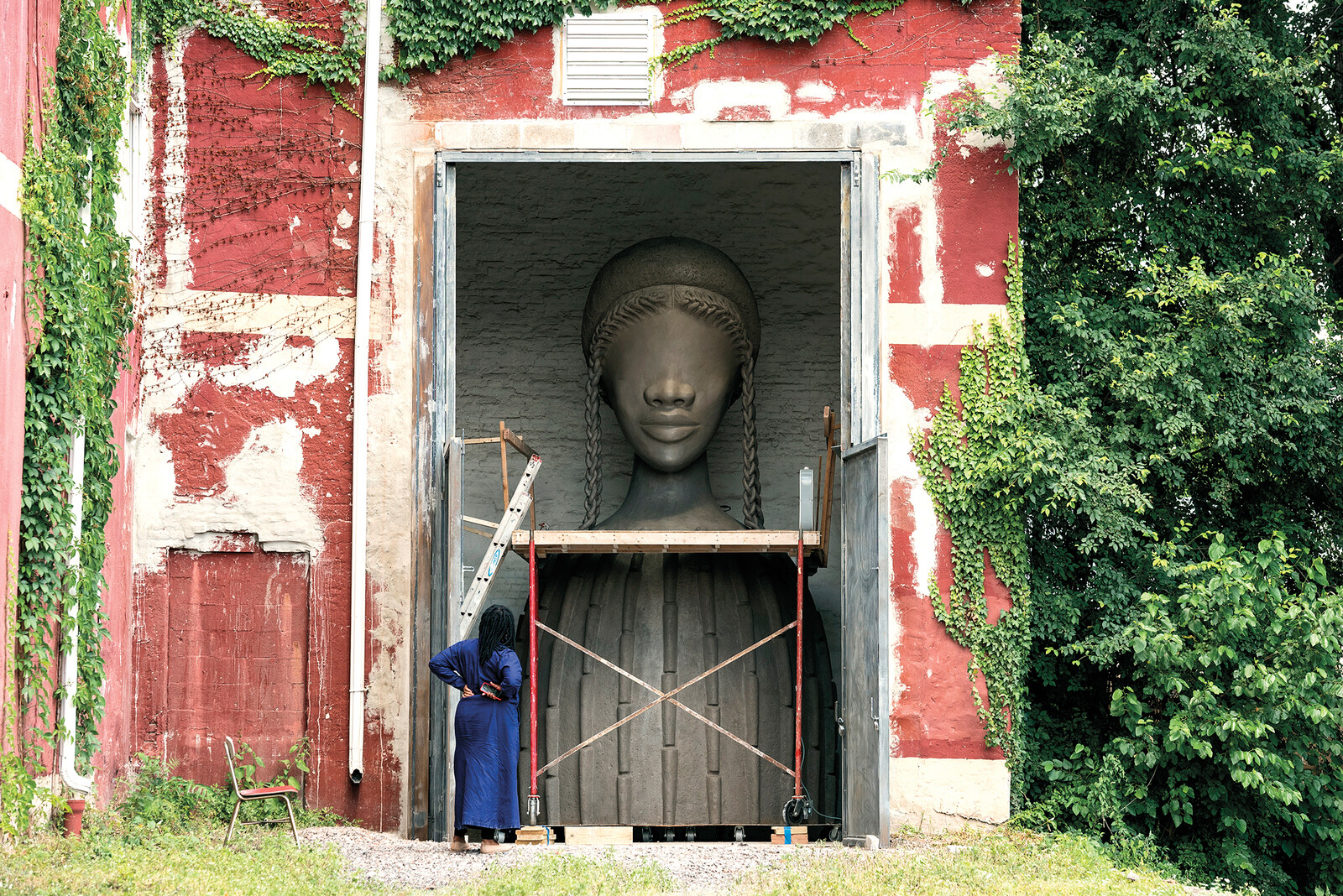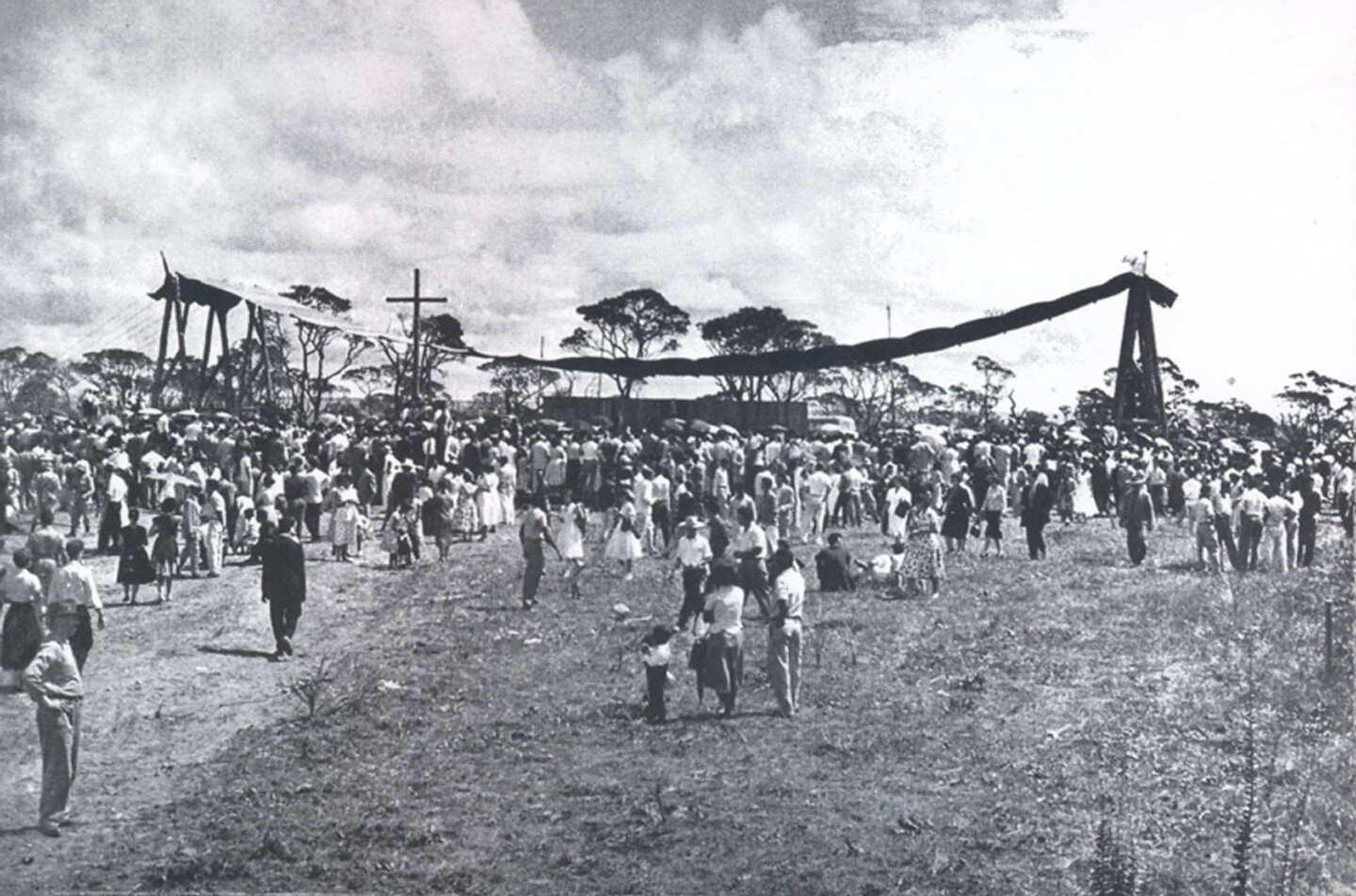When the CCA’s new Double Ground campus expansion opens in San Francisco in 2022, students will be learning and making on land where people have done so for thousands of years. Traces of human activity on the site from millennia ago were discovered during the planning process for the new campus, creating a remarkable opportunity for the CCA community to acknowledge, reflect upon, and learn about the full continuum of life on this land… Out of respect for these Indigenous ancestors and their descendants, CCA has chosen to refer to it as a cultural site, rather than the more commonly used but misleading terms “shellmound” or “midden.” The Double Ground building process involves building up, rather than digging down, minimizing disruption to the deeply buried cultural site.
—California College of the Arts1
This account represents the institution’s attempt to frame the expansion of a college teaching art, architecture, and design on top of Indigenous cultural remains as a gesture of respect, rather than the latest iteration in a long history of colonial appropriations and obliterations of Indigenous peoples, lands, and things.
What are the limits, displacements, and negations of a project devoted to “acknowledge, reflect upon, and learn about the full continuum of life on this land”? What sort of accountabilities remain unaddressed by compliance with bureaucratic procedures for the management of “Native American heritage”? How does the acknowledgment of Indigenous peoples as “first stewards” of land support and advance narratives of those peoples as vanished inhabitants of that land and naturalize settler colonialism? The California College of the Arts (CCA) expansion raises these and still other pressing questions around our settler colonial present. The following texts respond to these questions from a continuum of perspectives. These responses were written by representatives of the Indigenous peoples whose homelands are in and around San Francisco, Indigenous scholars, an architectural historian, and faculty of Decolonial School at CCA. We also invited Studio Gang, the architecture firm responsible for the CCA expansion, and representatives from the CCA administration to respond to our prompt, but each declined the invitation.
Our Ancestral Homeland
Jonathan Cordero
The Ramaytush Ohlone are the original peoples of the San Francisco Peninsula.
Like many other California Indians, the Ramaytush Ohlone were intimately tied to the natural world. Our ancestors understood the interconnectedness of all things. Nearly every plant and animal had a spirit and was to be treated with respect. The plants, animals, and waters sustained us, and in turn our ancestors held a responsibility for maintaining a harmonious relationship with nature. They did not over-fish, over-hunt, or over-harvest—they held an almost universal reverence for all of Mother Earth’s gifts.
Many of us hold firmly to that world view today—harmony with nature and with one another derive from our understanding of the interconnectedness of all things and with our reverence for the life-granting gifts of our Earth Mother.
In addition to a reverence for nature, the Ramyatush Ohlone endeavored to maintain harmonious social and political relations with their neighbors. Family members from different tribes intermarried, and it was not unusual for one child to be born in the father’s tribe and another child to be born in the mother’s tribe. Sometimes tribes even exchanged families.
Trade was another important reason why tribes tried to retain amicable relationships with one another. The Ramaytush Ohlone from San Francisco traded with the Pomo and Patwin to the north, with the Miwok and Yokuts to the east, and with the Awaswas to the south. It is that original spirit of inter-tribal (or inter-national) relations that resonates with San Francisco’s diverse, inclusive, and international character today.
Unfortunately, like most Indigenous peoples in the Americas, the Ramaytsuh Ohlone were adversely effected by Spanish, Mexican, and American settler colonialism that led to their near extermination and loss of culture, language, and land.
Prior to the arrival of the Spanish in 1769, the indigenous inhabitants of the San Francisco Peninsula, referred to as the Ramaytush, numbered about 1,600 persons. Only a few families remained by the end of the Mission Period in 1834. The rapid decline in population was the result of the austere living and working conditions at Mission Dolores, as well as the disastrous effects of European diseases on the Native population.
At Mission Dolores, life expectancy after baptism averaged only four-and-a-half years. By 1800, all of the Ramaytush Ohlone had been incorporated into Mission Dolores and eighty percent had died. By the time of secularization in 1834, only about five families of the original peoples of the San Francisco Peninsula were living at Mission Dolores. By the early 1900s, only one family from the entire San Francisco Peninsula is known to have survived. That family’s descendants constitute the Ramaytush Ohlone peoples today.
Today, like most Ohlone in the greater San Francisco Bay Area, we work with limited resources to rebuild our community, to revitalize our culture, and to reclaim our ancestral homeland.
As the original stewards of this land and in accordance with our traditions, we have the ancestral and spiritual responsibility to care for our Earth Mother and for all peoples who reside in our ancestral homeland.
Jonathan Cordero is Chair of the Association of Ramaytush Ohlone and Assistant Professor of Sociology at California Lutheran University in Thousand Oaks, California.
Trying to do the right thing?
John N. Low
The CCA is expanding its San Francisco campus, scheduled to open in 2022. According to the CCA post, “On This Land, A Cultural Site,” traces of human activity were discovered in the early stages of planning the expansion. It appears that for more than 7,000 years before contact with non-Natives, the site was a place where Indigenous peoples prepared shellfish for eating and engaged in other daily activities. No human remains or artifacts have been found at the site and it does not appear to be a place where the original peoples lived; rather, they used the area for the things you would expect of the residents of a coastal village on the Pacific Ocean, including harvesting and preparation of food. According to the CCA post, the CCA has labeled this place a cultural site “out of respect,” and declared that it will acknowledge the long history of life on the land by a “double ground” building process whereby new buildings will sit above the ground instead of on foundations dug into the ground. The CCA states that its intent is to respect the Indigenous ancestors and their descendants and minimize any disruption to the site.
According to information provided on the CCA website, the testing that determined the site was a place of Indigenous activity was conducted in consultation with an Ohlone descendant recognized by the California Native American Heritage Commission. The level and extent of any additional inclusion of the Ohlone in the process is unclear. If the CCA takes the opportunity to draft and adhere to the terms of a meaningful Land Acknowledgment, that can be good for Ohlone people. A well-conceived Land Acknowledgment can be broken down into four questions that should be answered within the text. Who is being acknowledged? What is being acknowledged? Why is the CCA community acknowledging the Ohlone and other Indigenous peoples? What are the CCA community’s responsibilities to the First Peoples of this land that follows from this acknowledgement? The point is, the CCA needs to do more than just thank the Ohlone for being on their land.
I cannot tell from the CCA website the level of engagement with the Ohlone peoples. According to its website, the CCA is making efforts to produce a decolonizing curriculum that sounds very interesting. But is this what the Ohlone want? The Ohlone might need other things first; perhaps support of their efforts to secure federal recognition of their native communities. Housing, education, and health care might also be on the list of Ohlone priorities. I do not think it is enough for an academic institution to offer academic initiatives. The CCA appears to be trying to do the right thing but they need to make sure what they do is aligned with Ohlone interests. This is not the time for the CCA to be telling the Ohlone and other Native peoples what they are going to do for them. It is a time to sit down and let the Natives speak. Let the Ohlone tell you how you can support them. After all, you are on their land.
I do appreciate how the CCA has expanded the idea of a cultural site beyond the usual village, burial, or ceremonial space. Most, if not all, of North America has been a place of Indigenous activity. As my elders taught me as a youngster, “we walk on the bones of our ancestors.” What they meant is that we have been here for so long and are so connected to where we live that we blanket the continent with our activities. There is no evading the reality that you are always on an Indigenous cultural site. I think the actions of the CCA affirm that understanding that we are everywhere. And again, while I cannot speak for the Ohlone, it is true that many American Indian peoples, including those from my community, revere the land enough to appreciate any efforts to avoid disturbing what my people refer to as nokmeskignan, grandmother earth.
I suspect many institutions that, either explicitly or by inference, engage in a Land Acknowledgement do so with good intentions. But the acknowledgment needs to be more than a note of who was here before. Without something more, it just becomes a reminder of displacement and removal: “living guilt free on stolen land,” as artist Bunky Echo-Hawk would say. If the institution only engages in actions and initiatives that members of that institution are interested in, it only compliments the institution and continues the erasure of native peoples.
To characterize the Indigenous peoples as “first stewards” harkens to what Ojibwe scholar and historian Jean M. O’Brien has termed “Firsting and Lasting.”2 Settlers in North America have a proclivity for seeing themselves as the rightful inheritors of the lands of others. Native peoples were more than “first stewards”; such thinking allows for the theft of our lands as a sequential and normal event and poses the descendants of the settler colonists now residing on our lands as the second, subsequent, and perhaps last stewards of the land. This is a false narrative. We were, and are, more than stewards. I cannot speak for the Ohlone, but most Native peoples of North America had a familial relationship to the land—it was, and is, our parent. We love the land, not as a commodity or resource, but as an essential part of who we are as Indigenous peoples. We are peoples of the land. So please do not dismiss us as mere stewards. We were not taking care of it until you could get here. You stole our land—our being, our soul. The CCA needs to clear a space and allow the Ohlone to explain their relationship to this land and respond accordingly. The Ohlone do not need saviors; they need allies.3
John N. Low is an enrolled citizen of the Pokagon Band of Potawatomi Indians, member of his tribes’ Traditions and Reparation Committee, and Associate Professor of Comparative Studies at the Ohio State University at Newark. He is also Director of the Newark Earthworks Center in Newark, Ohio.
Prayer for the Creators of the Past
Shalini Agrawal And Shylah Hamilton
Pours libation
Archeological testing was implemented for the Project [1140 7th Street, San Francisco] as part of the CCA’s compliance with mitigation measures identified in the Eastern Neighborhood Environmental Impact Report and in the Community Plan Evaluation dated June 20, 2018… Based on several lines of evidence, the shell deposit in Bore 14 and Bore 14b was determined to be cultural rather than naturally occurring.
—AECOM Memorandum Case No. 2016.001557ENV-024
Ibae to the architects, artists and designers of the Shell Midden site at the edge of proto-Mission Bay:
We, the architects, artists and designers of the future approach you with humbleness and respect. The private owners of this land have unearthed you in their quest to validate their power and sovereignty.5
Sustainable design and architecture is built into the process, not separated… We will create a space that will redefine arts education for the future…
—Stephen Beal, President, California College of the Arts6
We acknowledge burying the past when planning for the future.
Initial radiocarbon dating of the shell midden produced dates of approximately 7400 BP, making it the oldest known shell midden in the San Francisco Bay Area. The age of the site is particularly remarkable because, as noted in a recently published research design and treatment plan for Native American archeological resources in the San Francisco Bay-Delta region, there is a “dearth of knowledge regarding pre-Late Holocene record in the Bay-Delta Area.”
—AECOM Memorandum Case No. 2016.001557ENV-027
We have come to tell you that we see you, we hear you, and we are obligated to apologize. We apologize for not asking our Native elders for permission to share their land. For using modern architectural practices as an enduring tool of master planning enforcing colonialism, and building monuments of colonialism. We apologize for aligning with military forces to occupy your territory, to build a new world from “nothing.” For creating structures that are not of the land, but on the land and feel detached from belonging, no matter how many people fill it. We apologize for claiming sustainability while denying the rights of mother Earth.
Without knowing we would find evidence of your life, we founded Decolonial School. Our founders are small in number, but committed to the work. We reintroduce participatory, liberatory, and transformative research approaches based on Indigenous knowledge systems. We teach knowledge that is relational to reconstruct transformational social change for the colonized Other. We redefine design practices that have for generations been the root cause of trauma to Indigenous peoples and Black communities. We teach techniques based on philosophic sagacity, and speak truths informed from being one with the universe.
We founded Decolonial School to hold space for the multiple layering of realities that construct our coexistence. We have accepted our assignment. Thank you for what you have given us.
Respectfully,
Shylah & Shalini
Decolonial School Members
July 31, 2020
Shylah Hamilton and Shalini Agrawal are faculty at the CCA and members of Decolonial School, a collaborative initiative from CCA faculty of Design, Fine Arts, and Humanities + Sciences. Decolonial School is working to address CCA’s need for curricula that facilitate BIPOC methodologies and, in particular, local and global Indigeneity. Decolonial School was founded in Fall 2018 and launched in Fall 2019.
Reindigenization
Kanyon Sayers-Roods
“Yelamu” is what San Francisco was known as before it was San Francisco, before this was California, before this was the United States. Indigenous peoples have always been on these lands. It is due to Indigenous peoples that these lands have been so beautifully maintained; the land management practices and our relationship and responsibility to the earth. It’s important that we acknowledge and recognize the Indigenous protocol of becoming familiar with the peoples of whose land we are on. My mother and my grandmother believe that when song, ceremony, and dancing stops, so does the earth. I too believe that, and Indigenous peoples are still here.
All my life, I have been raised in an environment where my mother and my grandmother have instilled in me the belief system and compassionate understanding that if our ancestral remains are ever disturbed or removed from their resting place, then the spirit of that individual will be left wandering. My mother, Ann Marie Sayers, has dedicated the greater portion of her life to protecting sacred sites and ensuring that our ancestral remains and cultural resources are not desecrated or disturbed. It is important that if our communities’ ancestral remains are disturbed that they are re-interred into the earth ceremonially.
Having been raised in this environment, I have witnessed many organizations establish their buildings and upgrade their facilities attempting to follow CEQA and NAGPRA regulations and having Native American monitors on-site. In this process, I have always felt that the Native peoples are the last to be consulted or even acknowledged. I always found it troubling that governing structures and businesses can decide the full process of developing something new without ever having known that they can or should consult with Native peoples until navigating the last procedure of the environmental impact report where they have to follow CEQA regulations.
As CCA has been taking steps on their own as well as consulting and connecting with the Indigenous peoples in the community, I find their effort quite refreshing. They are choosing to be proactive and ensuring that their community and audience is informed or educated about the truth in history in this place, in this space, in this time. This is unlike other sites that my mother or I have monitored to ensure no human remains are found and that the job is done. In these situations, often only the construction workers that we work with have been informed that they are on native land and that respectful considerations should be taken. Cultural competency training is provided only for the people on-site.
It is one thing to acknowledge the land and the original stewards, but it’s another to take conscious action in the day-to-day efforts, to be an advocate for truth in history on an ongoing basis, to ensure that ever people can witness this information and have it be normalized, to take steps towards decolonization. I’m passionate about having these conversations about what “reindigenization” means when it comes to our procedures and practices going forward.
When we look at the word “de-colonization,” it breaks down and questions where the origin of our practices and procedures came about. “Reindigenization” is about bringing in an indigenous perspective and going forward with that knowledge of the current environment and considering what it means to be a good ancestor in training.
Kanyon Sayers-Roods (Costanoan Ohlone and Chumash) is CEO of Kanyon Konsulting, Cultural Director and COO of Costanoan Indian Research, and Cultural Representative and Native Monitor for the Indian Canyon Mutsun Band of Costanoan Ohlone; she also served as the official Ohlone consultant to the CCA in the evaluation of the campus expansion site.
Three corrections
Mark Jarzombek
The website for the CCA makes it abundantly clear that the CCA wants to acknowledge Native American presence on the site of their new campus expansion. “Traces of human activity on the site from millennia ago were discovered during the planning process for the new campus,” leads the CAA to include the Ohlone peoples, the “first stewards of the Bay Area,” into their discussions.8 But did the architects really listen? Seemingly not. They seem to be more concerned about tying the campus to the “the city’s design and innovation district.” The idea of two ground planes seems ingenious, but insufficient and is all-too predictable. The architects does not even mention that the site sits on Native American land or that the client’s interest in this matter was of any concern to them. The project is still basically a single-voiced, techno-modernist project, its glulam wooden beams notwithstanding. There should be places in the design that allow a different type of voice to come through. For this, I would propose three small “corrections” to the design:
1. The first thing to worry about is the “side-walk to sidewalk” approach that speaks the classic—and never to be contested—language of the metaphysic foreclosure of land ownership. The problem here is not how to respond to “the other,” but how to respond to one’s systemic history of injustice. To acknowledge this problem, I propose a one-inch-by-1,000-inches-long setback along one of the streets. This thin deep space would be “given” to the city, and would not pose much of a hardship to the client, but would serve as a symbolic gesture reminding anyone who notices that architects do not always have to fill the site with “architecture.”
2. The CAA website mentions that shell fragments from Ostrea lurida, or the Olympia oyster, were found in a six-to-ten-inch layer about forty feet below the surface. The oyster was not just food, but part of the lost relationship of human to the sacred landscape. The Ohlone community should be given the opportunity to design a wall—or propose some other intervention—that uses these shells. It would be a memorial to a lost culture, a pedagogical tool to understand the oyster and its fragile eco-systems (under threat along the Pacific Coast), as well as a radiant homage due to its shimmering luminescence.
3. Just as the settlers destroyed native spaces with hardly a thought, this project should give up at least a piece of space for programless-ness. It can have several semiotic references; the space outside of capitalism; the space of the non-human; the space of loss; the space of the “infinite.” But it should be a space, totally enclosed and inaccessible.
The three mini-projects would attack the design from three points of view: the plan, the wall and the spatial. They are not memorials or monuments, but places where difference (the difference to the totalizations of modernity) are recognized.
But what if the issue is not the architects, but the CCA itself? The article states that “CCA faculty and administrators are working to integrate the idea of land acknowledgement into the school’s culture.” If that means celebrating an archaeological dig, making a website about it, and patting themselves on the back, then they are missing the point of their own commitment. An “acknowledgement text” is a step in the right direction, but there are many more steps to take and many of these can be creative as well provocative and meaningful. This does not mean that a wholesale revision of the design, but perhaps, a set of small adjustments that “acknowledge” that this is not business (or modernity) as usual.
This project shows more than a disconnect between architecture and client, but also a disconnect in relationship to the potential for pedagogy. How do we teach architects to think beyond modernism’s naturalization of its self-interest?
Mark Jarzombek is Professor of the History and Theory of Architecture at MIT. He works on a wide range of topics, historical, theoretical, and philosophical. His most recent book is Digital Stockholm Syndrome in the Post-Ontological Age (Minneapolis: University of Minnesota Press, 2016).
On Indigenous Land
Sogorea Te’ Land Trust
Official statement regarding the California College of the Arts campus expansion onto the cultural remains of an Ohlone Shell Mound and calling it an honoring without giving back the land to Indigenous people:
Colonizers be colonizing.
Sogorea Te’ Land Trust is an urban Indigenous women-led land trust that facilitates the return of Indigenous land to Indigenous people. Sogorea Te’ is centered in Huchuin, the ancestral homeland of Chochenyo-speaking Lisjan Ohlone people, now known as the East Bay. This statement was issued on August 20, 2020 by Inés Ixierda, Director of Art and the Politics of Representation, Sogorea Te’ Land Trust, Unceded Ohlone Territory.
“On this land, a cultural site,” California College of the Arts, May 2020. https://www.cca.edu/newsroom/cultural-site-land-acknowledgement/
Jean M. O’Brien, Firsting and Lasting: Writing Indians out of Existence in New England (Minneapolis: University of Minnesota Press, 2010).
I realize there is a conversation in the literature about the term “allies.” For instance, see “Accomplices Not Allies: Abolishing the Ally Industrial Complex,” Indigenous Action, May 4, 2014, . http://www.indigenousaction.org/accomplices-not-allies-abolishing-the-ally-industrial-complex/ As I read the discussion, the point is that faux allies or superficial allyship is counterproductive. I agree. However, I do not reject the term “ally” in toto. I do agree that only a sincere effort at allyship by the CCA will benefit the parties.
AECOM, “Results of Archeological Testing for the Development Project at 1140 7th Street,” February 27, 2019. The AECOM memorandum case has not been published as it infers a follow-up report with an Ohlone monitor. As of the publication of this text, this process is paused due to COVID-19.
A Yoruba word used when speaking the name aloud of any ancestor who has died; it’s meant to honor the dead and to wish them the best in the other world.
“Singular Vision, Double Ground,” California College of the Arts, April 2020, . https://www.cca.edu/newsroom/why-unification/
AECOM, “Results of Archeological Testing.”
“On this land, a cultural site.”
The Settler Colonial Present is a collaboration between e-flux Architecture and the Settler Colonial City Project, with the support of the Department of the History of Art and Taubman College of Architecture and Urban Planning at the University of Michigan.
